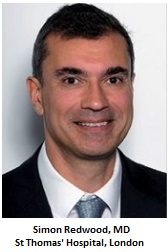How Should Fellows Learn From Live Cases? An Interview With Simon Redwood, MD
2016-2017 Fellow Talk Bloggers
 In the past 15 years, unprecedented advances in communication technologies have facilitated the delivery and progression of medical science, particularly for interventional cardiology. Satellite transmission of live case demonstrations have become a regular feature of many interventional cardiology conferences, and these are now seen as a fundamental part of physician education. The ability to demonstrate patient care in real time, promote clinical trials, and exhibit novel device technologies with an expert faculty panel make these demonstrations captivating.
In the past 15 years, unprecedented advances in communication technologies have facilitated the delivery and progression of medical science, particularly for interventional cardiology. Satellite transmission of live case demonstrations have become a regular feature of many interventional cardiology conferences, and these are now seen as a fundamental part of physician education. The ability to demonstrate patient care in real time, promote clinical trials, and exhibit novel device technologies with an expert faculty panel make these demonstrations captivating.
As fellows, we find live cases inspiring and educational, but what should we be taking away from them and how can they advance our medical education? To find out, I sat down with Simon Redwood, MD, professor of interventional cardiology and director of the cardiac cath lab at St Thomas’ Hospital (London, England)—one of 20 planned live case sites at this year’s Transcatheter Cardiovascular Therapeutics (TCT) symposium being held in Washington, DC, in late October.

We had been doing a number of local meetings with live cases teaching specific technologies such as IVUS, FFR, and laser atherectomy ever since I was appointed at St Thomas’. But the first national meeting was Advanced Cardiovascular Interventions, our annual British Cardiovascular Intervention Society meeting, when I was invited to do a case from Glasgow, Scotland. It was a tight, calcified distal left main lesion and about 20 minutes before going live, the patient became ischemic and developed progressive cardiogenic shock. I had to insert a balloon pump and rotablate quickly into the LAD and then circumflex. By the time we went live the situation had stabilized, and I managed to demonstrate a culotte technique successfully. Thankfully, the patient did very well after that.
The main change I have noticed is the development of broadband allowing transmission via the internet rather than satellite, which substantially reduces cost. However, the first few attempts were nowhere near as straightforward. Things have substantially improved, but there has also been quite a marked reduction in satellite cost, too.
St Thomas’ Hospital appears to be frequently selected for live case demonstrations at international interventional cardiology conferences. What makes a strong live case center?
The main factor is having all the cath lab staff recognize the importance of such demonstrations. Thankfully, we have excellent and highly motivated staff at St Thomas’, and we work very well as a team. They are always happy to help with all the background work of setting up before transmission as well as during the cases.
In your opinion, what makes for an educational live case? What are the ethical considerations that need to be taken into account?
I have seen many operators try to do very difficult cases, but I don’t think that’s necessary or sometimes ethical. Even what we may think is a very straightforward case can have a number of excellent teaching points. Importantly, the most educational cases are where the majority is actually done live rather than off camera, although the temptation to start the case is huge while waiting to go live!
What can fellows learn from live cases, and how can we approach this format in a structured manner?
It’s not just fellows. We all learn a lot from watching others approach a case and how they overcome difficulties. I do think attendance at meetings where there are live cases (as well as structured prerecorded cases) should be an integral part of an interventional fellowship. Simulators are now very realistic and should also be part of training.
What are the best and worst aspects of live case presentation in terms of physician education?
Live means live—rather than seeing what someone has already done. We’ve also seen cases where a substantial portion of the live time is essentially wasted on giving a detailed presentation of the patient’s history following by a prolonged panel discussion, then showing what’s been done off camera. This leaves very little time to see some action.
Live cases are viewed as a fundamental component of physician education. How do you think they will evolve over the next 5 years?
There has been a lot of talk about moving away from live cases and using only prerecorded cases for teaching. Although prerecorded cases are undoubtedly useful for teaching specific procedures and techniques, I hope live cases will continue as they offer a different educational experience and are often the highlight of meetings.
Tiffany Patterson, MBBS, is a second-year interventional cardiology fellow at St. Thomas' Hospital, King's College London (England). Since graduating from…
Read Full Bio

Comments